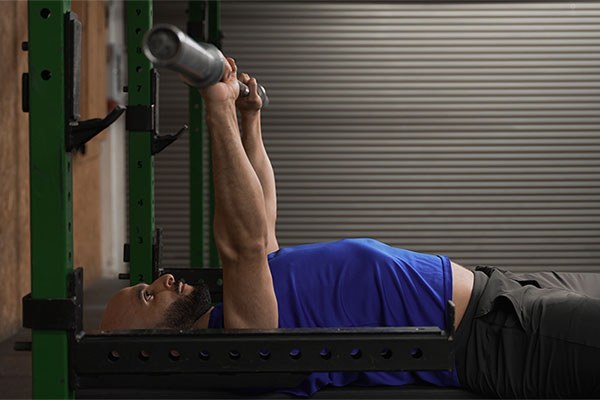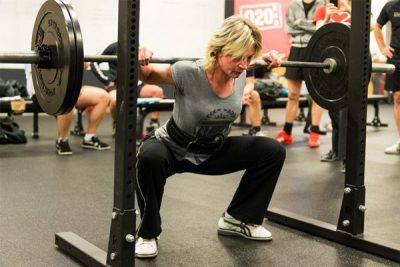
As someone who places a high value on safety in training, I often
find myself repeatedly convincing people to use safety pins during
their workouts, even those familiar with the Starting Strength method
and barbell training. It seems so fundamentally obvious to me that
taking basic safety precautions, especially when lifting heavy
weights, should not be overlooked. Yet, it happens often enough that
I feel the need to explain it over and over. In this article, I’ll
make a strong case for using safeties in the bench press and the
squat during every single session and explain how to do so easily.
Safety
Pins and Barbell Training
Safety pins are
adjustable bars that can be set at different heights in the rack to
catch the barbell if you fail a lift. When set correctly, they
provide a secure barrier, preventing the bar from pinning you down to
the ground during a squat or to the bench during a bench press. No
matter what happens during a set – whether the weight is too heavy,
you pull a muscle, lose balance, or something else entirely – if
the safeties are set correctly, the risk of injury is almost zero.
You’re covered.
Barbell training is
overall a very safe exercise regimen with a low risk of injury,
despite what some people think or fear. When done correctly, it’s a
precise, predictable activity with very few unexpected events, unlike
other sports. Especially when compared to physical activities that
involve other players, reactive movements, or imperfect terrain,
barbell training is exceptionally safe. There’s so little you need
to insist on in terms of safety apparatus to dramatically reduce even
this low risk of injury, and the use of safety pins is the most
fundamental way to achieve that goal.
You might wonder what
else affects safety in training as much as safeties do. The other
primary factors are using correct form and programming your training
properly, both of which are covered in great detail in Starting
Strength: Basic Barbell Training, 3rd
edition. These are worth investing in, but that’s a topic for
another article.
Why
Use Safeties? Two Primary Reasons
There are two main
reasons to use safeties. The first, more obvious reason, is to
protect yourself from injury that may be caused in the case of an
unexpectedly failing rep and not being able to get from under the
barbell safely. Trust me, if you train long enough, unexpected things
will inevitably happen. If you have the safeties set up beforehand,
you’re covered. The second, less obvious reason is related to
optimizing your strength gains by attempting reps you aren’t sure
you can finish. Let’s explore this reasoning further.
Getting
Stronger and Attempting Uncertain Reps
Strength training is
about progressively increasing your force production by lifting
heavier weights over time. This is the best – and essentially the
only – way to increase physical capacity and build noticeable
muscle mass. Since strength is defined as the ability to produce
force against external resistance, our strength only increases if the
weights we lift increase. As the weights get heavier, the effort
required increases, producing the stress needed to drive strength
adaptation. Eventually, you’ll face sets where you’re not
entirely certain you can finish. Attempting these uncertain reps is
crucial for continual progress in training.
Most often, you’ll
find that your perception or fear of failure is unfounded, but
occasionally, you might actually fail a rep. This is not only okay,
but an integral part of training. If you think you can’t finish the
next rep and choose to rack the bar instead of attempting it, you’re
basically limiting yourself to a mediocre strength level. If the
reason you didn’t attempt that rep was fear of injury due to the
lack of safety pins, then you’re engaging in negligent malpractice.
You always want to set
up the safeties because your progress depends on it. And you want to
set them up every single session because you never know when you’ll
truly need them.
Adjusting
the Safeties Each Session
It’s easy to forget
or neglect adjusting the safeties each session, especially when
you’re in a hurry. However, it’s crucial to take the time to set
them correctly every time you train – both for the squat and the
bench press. Taking a few extra seconds to adjust the safeties before
your first warmup can make the difference between a safe and a
dangerous training session. It’s that simple.
When you start out in a
new gym, find the correct height for the safeties and test the setup
with the empty bar to ensure it’s correct. After that, memorize the
height or write it down, as we usually train in the same facility
most of the time. Make it a personal rule to set the hooks and
safeties at the correct height before you start your warmup. No
additional steps are necessary.
Safeties
for the Squat
There’s a maneuver
some lifters use where they bail from under the bar during a failed
rep, trying to throw it back. This is highly unrecommended because it
requires you to get away from under the bar quickly enough to avoid
it rolling down your spine. It’s not easy to do safely.
Additionally, this means that during a very hard rep, instead of
focusing solely on pushing hard and maintaining form, you’re also
thinking about your exit strategy. A dropped barbell can damage the
equipment, endanger those around you, and, most importantly, put you
at serious risk.
Some people argue that
since top weightlifters use this maneuver, it’s probably okay.
However, just because elite athletes do something doesn’t make it a
good idea. It’s tricky to differentiate between what makes them the
best and what they succeed in spite of. Learn the good habits
instead.
If you squat long
enough, you may experience a rep where you lose balance and fall
forward. Without safety pins, the consequences of that are serious.
Safeties ensure that the barbell is contained and that your training
environment remains safe for everyone.

To set the safety pins for the squat, adjust them to about a
fist-width lower than the bar’s lowest point at the bottom of the
squat. Make sure they’re low enough so you don’t hit them on the
way down and that they’re still high enough to securely receive the
bar when you take a knee at the bottom of the squat.
Safeties
for the Bench Press
The bench press is the
one lift that is truly dangerous and can cause severe injury. If you
fail a rep, the bar can literally strangle you to death. Whether it
crushes your chest, throat, or belly, being pinned down under a
barbell is a life-threatening situation. While not using collars on
the sleeves when benching alone might allow you to slide the plates
off in an emergency, this doesn’t address the possibility of
dropping the bar. Even with a competent spotter, they won’t be able
to react quickly enough to catch a falling barbell.
Why might the bar drop?
Accidents happen. Your wrists can fail, the bar can slip, or it can
gather momentum in an uncontrollable direction. If a barbell drops on
your sternum, ribs, head, or throat, it can be fatal – and that has
happened before. All of these risks can be completely mitigated by
using safeties. It’s a no-brainer when you’re bench pressing a
barbell where you have no way to escape quickly from under it in case
of an emergency.
Setting up safeties at
the exact correct height for the bench press is a bit more
challenging because the margin for error is minimal. However, it’s
not impossible. Here’s what you should do:
Set the safeties at a
height that is lower than your chest when it’s pushed up hard
(i.e., in the correct setup for the bench press) but higher than your
chest when you let it cave in. Thus, during the set the bar will only
touch your chest which is held up high, but in the case of failure
you just lower your thoracic arch so it gets lower than the safeties
height. Some compression on the chest is acceptable as long the
safeties carry the full weight of the bar which cannot go any lower.
Unfortunately, most
bench press racks don’t have built-in safety pins, so you may need
to bench press inside a squat rack that has safeties. Sometimes the
spacing between available heights doesn’t allow for proper setup in
your situation, in which case you’ll need to find a workaround. You
can elevate the bench or place something sturdy on top of the
safeties to achieve the correct height (make sure it’s immovable
and safe enough when you improvise something). Think creatively, and
you’ll find a solution. If you have your own setup at home, invest
in proper equipment or ask a handyman friend to help you figure it
out.

Using safety pins during the squat and bench press is a simple yet
highly essential practice that can prevent serious injuries and allow
you to train with confidence. By prioritizing safety and ensuring
proper use of safeties, you can lift heavy weights, train hard, and
see meaningful results without putting yourself at unnecessary risk.
Safeties give you the confidence to push your limits without fear of
injury. Knowing that the pins are there to catch the bar if you fail
allows you to train harder and make consistent progress. It’s like
an insurance policy that costs practically nothing, requires no extra
effort, and is there exactly when you need it – even when you think
you won’t.






